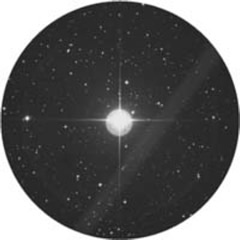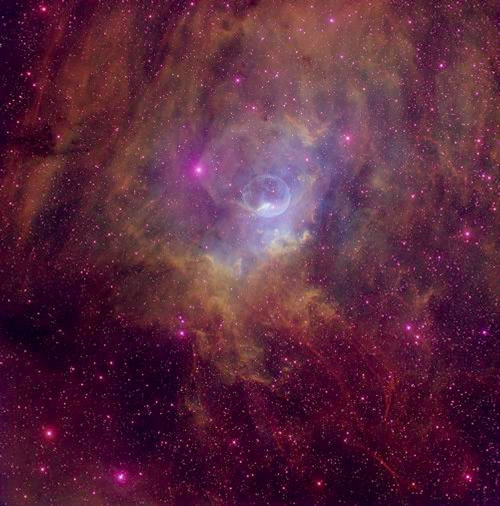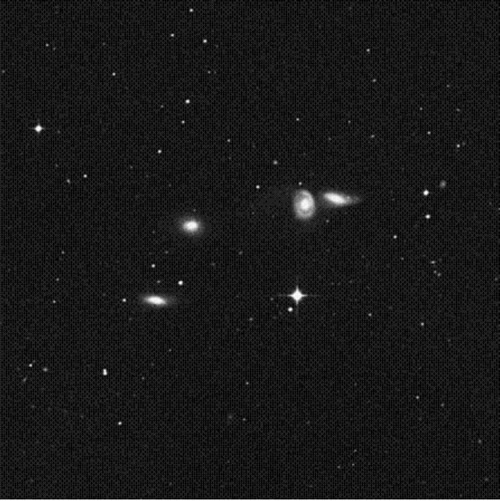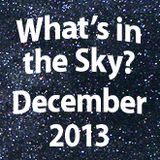
How to find the double star Theta Aurigae, the rapid variable star Beta Cassiopeia, the Bubble Nebula M52, and the faint, challenging group of galaxies known as Hickson 16 on the weekend of November 29-December 1, 2013.

Ham the Chimp Courtesy of NASA
Friday, November 29 - Today in 1961, Mercury 5 program launched Enos the Chimp into fame! His story is a long and colorful one, but Enos was a true astronaut. Selected to make the first American orbital animal flight only 3 days before the launch, he flew into space on board a Mercury-Atlas 5 and completed his first orbit in just under 90 minutes. Although Enos was scheduled to complete three orbits, he was brought back due to "attitude difficulties.'" But whose? Malfunctions caused the chimp to be repeatedly shocked when performing the correct maneuvers, but Enos continued to perform flawlessly and was said to run and jump enthusiastically on board the recovery ship. Although he died a year later from an unrelated disease, Enos the chimp remains one of our most enduring space heroes.

Theta Aurigae - Palomar Observatory Courtesy of Caltech
How about tonight we have a look at a challenging double star? All you have to do is locate Theta Aurigae (RA 05 59 43 Dec +37 12 45) on the east side of the pentagonal shape of this constellation. Located about 110 light-years away, 2.7-magnitude Theta is a four star system, whose members range in magnitude from 2.7 to 10.7. Suited even to a small telescope, the brightest member?Theta B?is itself a binary at magnitude 7.2; it was first recorded by Otto Struve in 1871.
The pair moves quite slowly and may take as long as 800 years to orbit at their separation of about 110 Astronomical Units (AU). The furthest member of this system was also noted by Struve as far back as 1852, but it is not a true member, with the separation only occurring thanks to Theta's own proper motion. While you are there, be sure to note Theta's unusual color. Although it will appear '"white," look closely at the diffraction caused by our own atmosphere, which acts much like a prism. You'll notice a lot more purple and blue around this star than many others of the same spectral type. Why? Theta is a silicon star!
Saturday, November 30 - Just as a curiosity, on this day in 1954, Elizabeth Hodges was struck by a five kilogram meteorite in Alabama. Duck!

Bubble Nebula - Credit: T.A. Rector/University of Alaska Anchorage, H. Schweiker/WIYN and NOAO/AURA/NSF
With no Moon present early, why not journey with me once again to Cassiopeia? We will start our studies with the western-most of the bright stars - Beta. Also known as "Caph," Beta Cassiopeiae is approximately 45 light-years away and is known to be a rapid variable. Viewers with larger telescopes are challenged to find the 14th magnitude optical companion to Caph at about 23" in separation.
Tonight, using our previous study stars Alpha and Beta, we are going to learn to locate a Messier object with ease! By drawing an imaginary line between Alpha and Beta, we extend that line the same distance and angle beyond Beta and find M52 (Right Ascension: 23:24.2 - Declination: +61:35).
Found on September 7, 1774 by Charles Messier, this magnitude 7 galactic cluster is easily seen in both binoculars and small telescopes. Comprised of roughly 200 members, this open cluster is roughly 3,000 light-years distant and spans approximately 10-15 light-years. Containing stars of several different magnitudes, larger telescopes will easily perceive blue components as well as orange and yellow. Also known as NGC 7654, M52 is a young, very compressed cluster whose approximate age is about the same as the Pleiades.
For those with large telescopes wanting a challenge, try spotting a faint patch of nebulosity just 36′ to the southwest. This is NGC 7635 (Right Ascension: 23:20.7 - Declination: +61:12), more commonly known as the "Bubble Nebula." Best of luck!
Sunday, December 1 - Born today in 1811 was Benjamin (Don Benito) Wilson. He was the namesake of Mt. Wilson, California - home to what once were the largest telescopes in the world - the 60" Hale and the 100" Hooker. Later, three solar telescopes were added on the mountain - two of which are still in use - as well as the CHARA array and active interferometers. It was here that Edwin Hubble first realized the "nebulae" were distant galaxies and discovered Cepheid variables in them.
As we approach the end of our SkyWatching year together, let us pretend the skies are still as dark as they were on Mt. Wilson tonight as we take on a real challenge meant for a large telescope. Start by aiming about 4 degrees east of the Zeta and Chi pairing in Cetus to have a look at Hickson Compact Galaxy Group 16 (RA 02 09 31.71 Dec -10 08 59.7).

Hickson 16 - Palomar Observatory Courtesy of Caltech
Consisting of four faint, small galaxies designated as NGC 835, NGC 833, NGC 838 and NGC 839 clustered around a 9th magnitude star, these aren't for a small scope - but are a true challenge for a seasoned observer. Groups of galaxies such as Hickson 16 are believed to be some of the very oldest things in our Universe - and this particular one has a reputation of having an extremely large amount of starburst activity that is close enough for scientists to study. They were all cataloged by William Herschel in this month (on the 28th) in 1785. The northernmost, NGC 833, is known as HII.482, roughly magnitude 13, followed by NGC 835 (HII.483) which holds a magnitude 12. Next in line is NGC 838 (HII.484) at close to magnitude 13, followed southernmost by NGC 839 (HII.485) at magnitude 13. Not easy, but this beautiful crescent of four is worth the effort!
About Tammy Plotner - Tammy is a professional astronomy author, President Emeritus of Warren Rupp Observatory and retired Astronomical League Executive Secretary. She's received a vast number of astronomy achievement and observing awards, including the Great Lakes Astronomy Achievement Award, RG Wright Service Award and the first woman astronomer to achieve Comet Hunter's Gold Status.


















